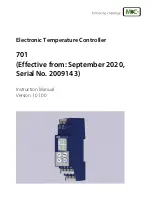
© 2018 Baker Hughes, a GE company. All Rights Reserved.
Masoneilan Regulators Models 525 & 526 Manual | 4
F.
Plug stem (5) and plug (4) sub-assembly can now
be removed together as one unit from the
bottom of the valve.
Care must be taken to avoid damage to the plug and
upper bushing (23).
G.
Remove old packing (16) [and optional lantern
ring (17) if a leak detection connection has been
installed]. Refer to Figure 2.
H.
All components may now be inspected for wear
and service damage. After determining the
maintenance required, proceed to the
appropriate Section of this instruction manual.
8.
Maintenance & Repair
The purpose of this section is to provide recommended
maintenance and repair procedures. These procedures
assume the availability of standard shop tools and
equipment.
8.1
Failure to shut off
If there is excessive leakage through the valve when it is
shut off, the cause may be foreign matter holding the plug
off the seat. If so, disassemble and clean. If leakage is the
result of normal wear, regrind the seating surfaces or, if
necessary, replace the plug and/or seat rings.
8.2
Bushing Removal
The bushing (23) is press fit into the bonnet and blind head.
This part does not normally require replacement. If
necessary, it may be pulled or machined out. When
machining the bushing out, care must be taken to
maintain proper dimensions and tolerances in the bonnet
or blind head. These will be furnished upon request.
8.3
Lapping Seats
Lapping Seats Lapping is the process of working the valve
plug against the seat ring with an abrasive to produce a
close fit. If valve leakage is excessive, lapping becomes
necessary. The plug and seat ring seating surfaces should
be free of large scratches or other defects, and the
contact surfaces of the seats should be as narrow as
possible. This may require dressing both parts in a lathe.
A good grade of fine grinding compound is required for
the lapping operation.
The compound should be mixed with a small quantity of
lubricant such as graphite. This will slow the cutting rate
and prevent tearing of the seating surfaces. The amount
of lapping required depends on the materials, condition of
seating surfaces, and accuracy of machining. If a short
period of lapping does not visibly improve seating, there is
usually no advantage in continuing as excessive lapping
may result in rough seats. The only remedy is replacement
or re-machining of one or both parts. When lapping new
plugs and seat rings, begin with a medium fine (240 grit)
and finish with a finer grade (600 grit).
NOTE: Lapping should produce a line contact area, not the
entire surface.
Caution: Before lapping, the plug and stem sub-assembly
must be concentric. (See pinning operation, section 8.4).
8.3.1
525 (Reducing Service)
1.
CIean body gasket surface areas.
2.
When seats have been removed, insure that the
sealing surfaces in the body bridge and the
threads are thoroughly cleaned.
NOTE: A sealant compatible with the process should be
applied sparingly to the seat ring threads and sealing
shoulder.
3.
lnstall and tighten seat rings using fabricated
wrench used for removal.
Do not over-tighten. Do not strike seat ring lugs directly.
This could distort the seat ring resulting in seat leakage.
4.
Apply lapping compound on the plugs at several
spots equally spaced around the seating area.
5.
lnsert the stem and plug sub-assembly carefully
into the body until it is seated.
6.
Place bonnet (8) on the body and fasten the
bonnet to the body using four body stud nuts (10)
spaced equally apart. Apply slight pressure and
tighten evenly.
Do not tighten nuts to final torque specifications at this
time. The bonnet is used temporarily for guiding purposes
only.
7.
lnsert two or three pieces of packing (16) into the
packing box to assist in guiding the stem and
plug during lapping.
8.
Screw a drilled and tapped rod with a T-handle
onto the plug stem and secure with a locknut
(see Figure 3).
NOTE: As an alternative, drill a hole through a flat steel
plate and fasten to the plug stem using two locknuts.
9.
Apply slight pressure on the stem, and rotate the
stem in short oscillating strokes (around 8 to 10
times). Repeat this step as necessary.
NOTE: The plug should be lifted and turned 90° each time
before repeating Step (9). This intermittent lifting is
required to keep the plug and seat rings concentric during
lapping.
Содержание Masoneilan 525
Страница 4: ......

































